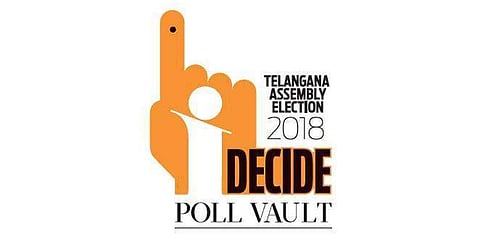

HYDERABAD: Politics in the Telangana region has never seen a dull moment, enjoying a thriving dynamic existence stretching back to many many years before the creation of the State. Though several major changes have been witnessed since 1952 in terms of the representation of various castes and religions in the Assembly, privileged castes have forever ruled the roost in Telangana -- the once-dominant Brahmins fell from grace only to be replaced by the economically and socially powerful Reddys and Kammas. None of the politically dominant castes have, however, been numerically strong -- BCs, SCs, STs and minority communities combined make up for 90 per cent of Telangana’s population.
First among equals
Though the number of persons from backward classes (BCs) was conspicuously low in the 50s, it has increased over the years owing to several factors including improved social awareness among the group. Nonetheless, only five of the 100-odd BC castes in the State have been able to make a significant mark in politics. The number of Muslim MLAs has hovered between eight and nine in Telangana and the number of Velama leaders in the Assembly too is usually between eight and twelve.
“Reddy is a political caste in Telangana. Reddys are economically and socially strong, which is why all political parties here give a major chunk of their seats to Reddys,” political commentator and senior journalist Kommineni Srinivasa Rao told Express. The TRS too is populated mostly by wealthy Reddys. Though they have the numbers, it will be difficult, if not impossible, for backward classes to enjoy such clout as they are segregated. Bringing all 119 subcastes of the category under one roof will be an onerous task, he pointed out.
The analyst, who has been researching Telangana’s social equations for the past several years, opined that K Chandrasekhar Rao became Chief Minister not by virtue of his caste. “He helms the State because of his ability to lead. He is a leader beyond caste,” Srinivasa Rao said. It is relevant to note that though Velama leaders Rao and T Harish Rao have recorded victory after victory from Siddipet Assembly segment since the mid-80s, the total population of the caste in the area is very less.
While the Velamas and Reddys hold fort in Telangana, the Kammas, Kapus and Reddys dominate politics in Andhra Pradesh. However, there’s no rivalry between politically strong castes in Telangana as in its neighbour.
How the mighty fall
Immediately after Independence, Brahmins dominated the political landscape in the region — 26 of the varna were elected MLAs in 1952. Many of the caste had participated in the freedom struggle and wielded control over the State, but their influence began declining in 1957. In 1957, the number of Brahmin MLAs in the Assembly slumped to 18; in 1962, their strength shrunk further to 12; in 1972, it was nine. From then on, their numbers in the Assembly has hardly exceeded three.
GS Melkoti Vaidya Kasinatha Rao, Burgula Ramakrishna Rao, MS Rajalingam won on Congress ticket and Pendyala Raghava Rao, KL Narasimha Rao and other Brahmins won on PDF tickets. Burgula Ramakrishna Rao became the first Chief Minister of erstwhile Hyderabad in 1952. The Assembly formed in 2014 had just two Brahmins — NVVS Prabhakar and Satish Kumar.
Figures same, parties change
The number of Muslim MLAs has since 1952 consistently been around 8. Before the AIMIM was founded, persons from the community were elected mostly from the Congress. Masuma Begum, who won from Shalibanda Assembly segment in 1952, became the first Minister from the minority community during Damodaram Sanjeevaiah’s reign. The creation of the AIMIM didn’t lead to any quantum jump in the community’s numbers in the Assembly.
The Reddy wave
Reddys are now identified as a strong ‘political caste’, but their position wasn’t always the same. In 1952, leaders of the caste were 24 in number in the Assembly, including nine from Congress and ten from PDF. Prominent among them were Survaram Pratap Reddy, Marri Chenna Reddy and Paga Pullareddy. Over the years, the number of Reddys in the Assembly picked up — there were 31 MLAs of the caste in 1957; 39, 1962; 36, 1967; 34 1983; 35, 1985; 40, 1989; 35, 1994; 31, 1999; 44, 2004; 40, 2009; and 42 in 2014.
The caste enjoyed a significant presence in the party until its leadership was taken over by N Chandrababu Naidu. “After Naidu became powerful in TDP, caste equations changed. The Reddys began working against the TDP and the Kammas against the Congress,” Srinivasa Rao explained.
Small in numbers, yet strong
The Kamma population in Telangana is negligible, but their presence is not. The caste wins a few seats every election — in 2014, 5 of Telangana’s MLAs were Kammas and one — Tummala Nageswara Rao — was made minister.
Disproportionate presence
The representation of Backward Classes (BCs) in the Assembly has increased over a period of time, but it is not in accordance with their population. In 1952, the number of Backward Classes MLAs was just four or five. There was no major change in Backward Classes representation even in 1962. “In 1972, the number of BC MLAs rose to 20 after then Congress supremo Indira Gandhi began focusing on social justice,” pointed out Srinivasa Rao. The number of BC MLAs rose to 24 in 2009, but most were from socially strong subcastes — ten from Munnuru Kapu, five from Gowda, three each from Mudiraj and Padmashali and one from Rajaka.
Reserved seats
Persons belonging to Scheduled Castes and Scheduled Tribes have been getting due representation in the Assembly as per their population in accordance with the provisions of the Constitution, but interestingly, though people from the communities used to win general seats earlier, the introduction of reserved seats has made it next to impossible for them to win general seats